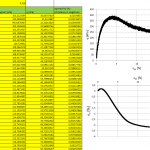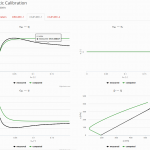Hello guys. I just tried to calibrate on soilmodels. I´ve done three CIUP-REC-test plus one oedometric test. As you can see in the images, that there is still something quite wrong. Can someone help me with a clue please? ps. The Image Shows only two CIUP-REC, thats because i tried to detect my mistake
Looking for help
Related Articles
-
Hypoplastic rate independent and non-linearity
 sobhan abedinnejad||Constitutive Modelling|2 |Views 3,941
sobhan abedinnejad||Constitutive Modelling|2 |Views 3,941
Dear all I’m studying hypo-plastic constitutive law from beginning concepts I traced concepts successfully until i faced **rate independent topic** i read this topic in the prof. Wolfgangs paper (hypo-plasticity […] -
UDSM PLAXIS
 nasim aftahi||Constitutive Modelling|2 |Views 4,642
nasim aftahi||Constitutive Modelling|2 |Views 4,642
I implemented a unified dynamic soil model, but PLAXIS doesn’t calculate any strains, and it prints zero (or some times NaN amounts) into a text file. I’d like to know […] -
testing an User Defined Soil Model in plaxis
 MIGUEL VALENCIA GALINDO||Constitutive Modelling|2 |Views 4,810
MIGUEL VALENCIA GALINDO||Constitutive Modelling|2 |Views 4,810
Hi everyone I am writing a code for a model in the UDSM format for Plaxis. I already have the “*.dll” files, but when I run the soil test I […] -
Constitutive Model for clayey sand Soils Considering the Effect of Intergranular Physicochemical Forces
 Mehdi Ghatei||Constitutive Modelling|0 |Views 4,086
Mehdi Ghatei||Constitutive Modelling|0 |Views 4,086
Hi all, I’m doing some experimental work to investigate the salinity effect on clayey sand behaviour. Is there any constitutive model considering the physicochemical forces for such materials? Regards, Mehdi -
Difference between ExCalibre and Plaxis for Oedometer test
 Marco Hofer||Constitutive Modelling|3 |Views 4,208
Marco Hofer||Constitutive Modelling|3 |Views 4,208
Hello all, i did the automatic calibration for the Dobrany and Motol sand and tried to model the soil tests also in Plaxis and then to compare both. For the […] -
Automatic calibration software ExCalibre has been launched
 David Mašín||Constitutive Modelling|0 |Views 4,398
David Mašín||Constitutive Modelling|0 |Views 4,398
On behalf of the team of developers I am happy to announce that, after more than four years of development and testing, ExCalibre has just been launched. ExCalibre is a […] -
Modelling TX monotonic compressive test with ABAQUS and SANISAND – not working
 Riccardo Zabatta||Constitutive Modelling|9 |Views 4,497
Riccardo Zabatta||Constitutive Modelling|9 |Views 4,497
I am trying to reproduce a TX monotonic, compressive test on a sand by using a 1-element, axisymmetric ABAQUS FE model, assigned to a SANISAND material. For this purpose, I […] -
Implimentation of SANISAND constitutive model in ABAQUS/Standard for a soil-monopile interaction
 philip alkhoury||Constitutive Modelling|4 |Views 5,206
philip alkhoury||Constitutive Modelling|4 |Views 5,206
Dear all, I am trying to model soil-monopile interaction (3D) in ABAQUS/Standard in order to perform subsequently a cyclic and dynamic analysis. For the soil I am using the SANISAND […]
Who is Online
No one is online right now
Search SoilModels Website
Recent posts
-
 Degradation ( disturbance ) of hypoplastic clay 23.4.2024
Degradation ( disturbance ) of hypoplastic clay 23.4.2024
-
 Degradation ( disturbance ) of hypoplastic clay 23.4.2024
Degradation ( disturbance ) of hypoplastic clay 23.4.2024
-
 Paper of Coulomb, C. A. (1773) 15.4.2024
Paper of Coulomb, C. A. (1773) 15.4.2024
-
 ABAQUS UMAT of hypoplastic clay model 6.4.2024
ABAQUS UMAT of hypoplastic clay model 6.4.2024
-
 Prague Geotechnical Days 2024 “Geotechnical monitoring” and 30th jubilee Prague Geotechnical Lecture by prof. Eduardo Alonso 5.4.2024
Prague Geotechnical Days 2024 “Geotechnical monitoring” and 30th jubilee Prague Geotechnical Lecture by prof. Eduardo Alonso 5.4.2024
-
 UMAT for Creep-SCLAY model. 1.3.2024
UMAT for Creep-SCLAY model. 1.3.2024
-
 Cyclic tests with Triax element test driver 14.2.2024
Cyclic tests with Triax element test driver 14.2.2024
-
 SUMMER SCHOOL ‘Numerical Modelling in Geotechnical Engineering’, Innsbruck – July 22nd-26th, 2024 1.2.2024
SUMMER SCHOOL ‘Numerical Modelling in Geotechnical Engineering’, Innsbruck – July 22nd-26th, 2024 1.2.2024
-
 COURSE IN SOIL MODELING – NTNU, Trondheim – October 14th to 18th, 2024 21.12.2023
COURSE IN SOIL MODELING – NTNU, Trondheim – October 14th to 18th, 2024 21.12.2023
-
 MSE walls design in Plaxis 11.12.2023
MSE walls design in Plaxis 11.12.2023
-
 sand liquefaction modelling in Anura3D 8.12.2023
sand liquefaction modelling in Anura3D 8.12.2023
-
 BCV bentonite experimental and modelling datasets 14.11.2023
BCV bentonite experimental and modelling datasets 14.11.2023
Recent Comments
- KHA DIDJA on Animating Soil Models
- Jh Xue on Undrained Tests with Clay Hypoplasticity Intergranular
- Zhentao Liu on Problem in simulating CPT using SANISAND04
- Gertraud Medicus on ABAQUS UMAT of hypoplastic clay model
- Chen Zhiming on Download Package of Charles University Implementation of High Cycle Accumulation Model
- Konstantinos Chatzis on Cyclic tests with Triax element test driver
- Abhay Pratap Singh on Cyclic tests with Triax element test driver
- Giovanni Ciardi on Cyclic tests with Triax element test driver
- Konstantinos Chatzis on Cyclic tests with Triax element test driver
- Ismail Khan on Cyclic tests with Triax element test driver
- Kanika Lamba on Cyclic tests with Triax element test driver
- Arie Koot on How to model the settlement in soil due to water drawdown.
- Konstantinos Chatzis on Cyclic tests with Triax element test driver
- Jose Duque on Cyclic tests with Triax element test driver
- MohamadReza Kamali on How to model the settlement in soil due to water drawdown.
- Leo Alibert on MSE walls design in Plaxis
- Ignacio Zuloaga on MSE walls design in Plaxis
- Giada Orlando on Problem with VUMAT interface







Hi Axel, in fact, your experimental results are quite untypical, as dilatancy starts from the very beginning of the shear experiments (normally, certain compression takes place first, as predicted by the model). I am not sure whether there could be some experimental issue in this but in any case I would consider predictions quite good, it would be probably quite hard to get better predictions using manual calibration. You can try to compare both sand and clay models to see the difference.
Thanks for your quick reply. Ich changed the signes because the template says that dilatancy should be negative. So after changing it the other way around I got still the same results. I was wondering, why it doesnt show anything in the strain chart?
It is undrained test, right? So volume strains are zero
That´s right. Thanks a lot
Kind regards